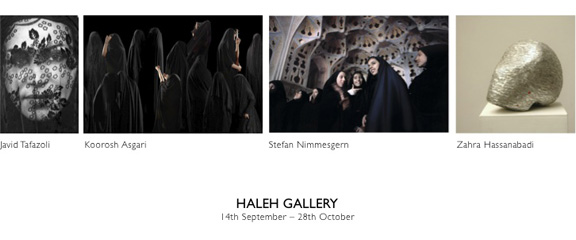THE JOURNEY CONTINUES

Opening: 14 September 2012, 6 p.m.
Travelling sharpens our view: our sense for the unknown, which we discover as something new, as well as for the familiar, which we can see with fresh eyes on returning home. With The Journey Continues Haleh Gallery gathers four artists who have extensely travelled Europe and Iran, thus being able to mediate between the perspectives of both cultures. In striking photographs, films and sculptures, Stefan Nimmesgern, Koorosh Asgari, Javid Tafazoli and Zahra Hassanabadi develop their very personal vision of the country. By making their way through Iran, the artists reveal a society which is also on its way: striving for modernity and yet trying to save its social traditions.
Stefan Nimmesgern (*Saarlouis / Germany 1956) received wide publicity in 2005 when he joined Reinhold Messner on an expedition that led to the discovery of the remains of Messnerʼs brother Günther, who had died on Nanga Parbat in 1970. The pictures Nimmesgern brought back from Iran one year later are more quiet, but no less intense. They document the countryʼs people and culture from a Western photographerʼs point of view, but also in the light of a family history which is closely linked to the Middle East. Nimmesgernʼs grandfather, an architect, had been involved in the redesign of several Iranian cities, including Isfahan with its famous Naghsh-e Jahan Square. In the work of his grandson, memories of the faded splendour of old Persia mingle with the experience of todayʼs Iran split between past and progress: „I saw the contradictions, the social fractures, the struggle of women, sometimes conducted with tactical cleverness, sometimes with particular vehemence. A struggle for freedom and Western values – but also the contrary, the strong resistance that seeks to obstruct all these efforts. My camera became witness of this process. In silent pictures I show people, mostly women, who dare to set off for a different future.“
This specificly female contribution to social change is what the works of Koorosh Asgari and Javid Tafazoli emphatically claim respect and attention for. In his short film Shahrbanu (5:30 min. / 2012), Koorosh Asgari (*Tehran 1972) captures the proud beauty of Iranian women. With outstanding elegance they wear the Hijab, the traditional body covering made of black cloth, which, however, hides them from view and makes them disappear as individual personalities. Thus, the softly flowing, mysteriously dark veil stands as a symbol for both an intimate space of female grace and dignity as well as for the invisibility of women locked into the textile corset and locked out of social life.
Javid Tafazoli (Bojnord / Iran 1982) analyses such mechanisms of exclusion in his photographic studies. His portraits of fully veiled women tell of the loss of female identity through its symbolic and factual suppression from a male-dominated public: „Our face mirrors our soul: our fears, happiness, and anger. For someone you cannot look into the eye you can have no sympathy or understanding. A person without a face cannot communicate; his or her gestures, feelings, demands, wishes become incomprehensible. Take the face from someone, and you take away his very self.
For Zahra Hassanabadi (*Shiraz / Iran 1964, lives in Germany since 2001), dehumanisation is a universal phenomenon that occurs whenever and wherever power and powerlessness are asymmetrically distributed. Her sculptures and installations therefore aim at immediate encounters and emotions that communicate through the material’s poetic value. In her Heads series, she uses suggestive textures to turn the archetypical form of a skull into a metaphor of human vulnerability: pointed toothpicks make us think of painful stitches, rough steel wool evokes the idea of aggression against the human body. An impression of fragility and even delicateness, however, adds to these feelings of physical and mental violence and keeps the spectatorʼs associations in balance. This ambivalence becomes particularly apparent in Hassanabadiʼs heads made of white textile filling, which is tightly wrapped with white sewing thread like the cocoon of a butterfly. Thoughts, dreams, hopes are sheltered behind this web of yarn – but they will never break free and fly. Sensual and resistant, drawing on pictorial traditions of Iranian culture and concepts of Western art, the works of Zahra Hassanabadi deal with the personal experience of a twofold distance: towards her former home Iran, and towards Germany, which she has yet to explore as a possible home. Against the background of her own biography, the artist questions the conditions and constraints of humanity not only with regard to the country of her childhood and youth, but to every modern society.
The journey must continue, everywhere, step by step.
PREVIEW Having casted a fresh light on Iran in September, Haleh Gallery will present an entirely new perspective on Germany in November: We are looking forward to showing the spectacular birdʼs eye views of Gerhard Launer, one of Germanyʼs most recognised aerial photographer.
